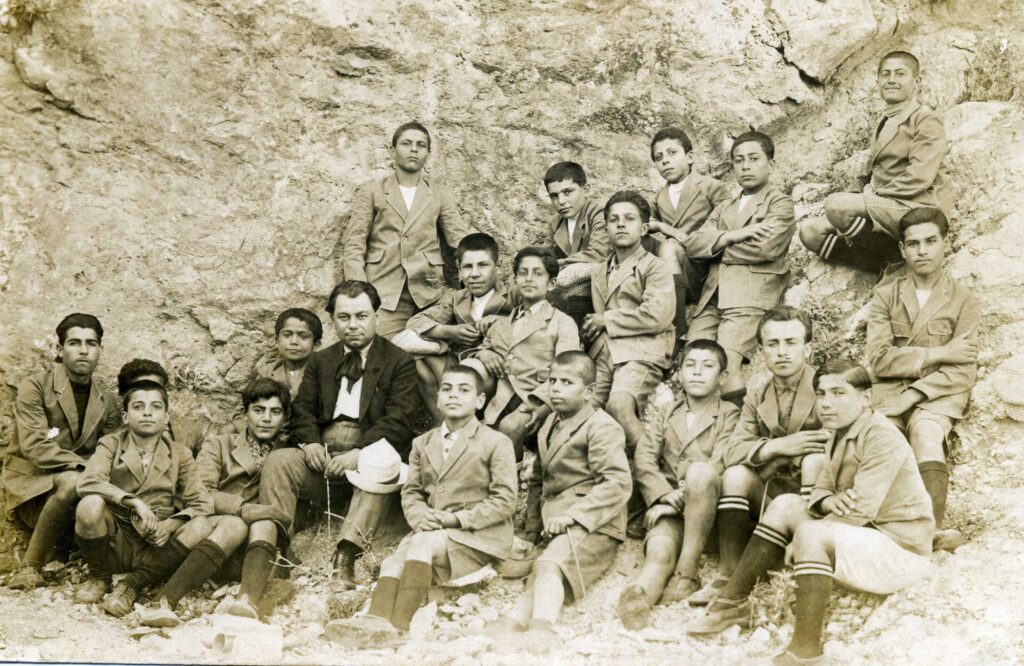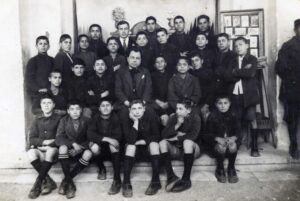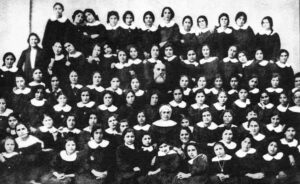Several years ago, while browsing through my father’s archives, I found a yearbook of 1924, published in France by Theotique, who came from Istanbul and was a member of the Armenian intelligentsia of the time. It chronicles the activities of 1922-1923, the difficult years of the Armenian exodus, after the Greco-Turkish war of 1919-1922, when the large Armenian communities in Europe and America were established. There was an extensive reference to the Armenian population in Corfu.
A great number of refugees settled on the island, along with many orphanages, as well as teachers, and scholars. These people travelled throughout the island in 1923 and collected and recorded the history of the Armenians from 1550 to the 1920s.
The Armenian community in Corfu town
The core of the new Armenian community in Corfu town had been created 16 years earlier, by the Markosian brothers and Boghos Zaroukian from Kemah. They had a coffee house at a very central spot downtown, and they supported their fellow countrymen, who arrived as refugees in November and December 1922, after the Greco-Turkish War. There were approximately 3,000 refugees, 2/3 of which women and children, not counting the orphans. They mainly came from the cities of Akser, Konya and Caesarea. The number of the Christian refugees who arrived in Corfu from the Turkish heartland and from Pontus were initially 22,000. Approximately 17,000 remained, while 5,000 left for Thessaly. 400 Armenians were among them. The authorities gave 20-40 square metres of land per family for agriculture. Our people were scattered in the various quarters of the town, in the village of Potamos, and some families in distant villages like Synarades. They were prepared to work hard but they faced indifference and denial by the locals to be given any kind of work. Many lost their lives because of the hardships and the difficult conditions. Nevertheless, we will always remember the care and the hospitality shown to both peoples, without any discrimination, by the mayor, N. Farmakis.
Charity Organisations
The American Red Cross, led by Dr. Godfrey, was the first who came to assist the Armenian refugees. They helped distribute food and medication. At the end of the summer of 1924, Dr. Godfrey transferred his activities to the local charitable institutions.
The British Society of Friends
Its manager was Miss Burgess, a young active English woman with philanthropic action in Istanbul, a philarmenian. She left, in 1922, along with twenty young Armenian women, students of cottage industry at Mitchen House in Istanbul. They settled in a villa, at the village of Alepou in Corfu, where under Miss Christine’s management, they continued their studies, while participating in the philanthropic action of the Institution. The Mitchen House was established in Garitsa. There, on Sundays, pastor Ovanes Tzetzizian and Mis Burgess preached. Her speech on the Treaty of Lausanne caused quite a sensation.
In addition to the charitable institutions, there were also several orphanages for boys and girls on the island, under British and American management, which literally saved the Armenian children from this monstrosity. Many great teachers and scholars, who survived the genocide, taught at these orphanages, providing high-level education at the time, cultivating patriotism, and teaching them the necessary qualifications to make a living.
Lord Major’s Foundation
They transferred 750 orphan boys and girls, under the management of Dr. Kennedy. The manager of the boys’ orphanage is Sir Robert Crevesy and the teacher of the school is the scholar and musicologist, Kevork Garvarentz, who was headmaster for eight months and was succeeded by professor S. Chatsantourian. The girls’ headmistress is Mrs. Fenzi and their teacher, Mrs. Diratsian. In addition, M. Fred established technical schools after the American technical schools for shoemakers, tailors, and carpenters, where the orphans could be taught and work. The manager of this organization provided food and clothes in the winter, worth of 500 pounds, to those in need.
Fabre Boys Home
It is the small orphanage from Skoutari with 16 orphans, which was secretly transferred from Istanbul, when the political riots broke out. It is managed by Mrs. Noemi and the headmaster is Agop Alotzian. This philarmenian and expert in Armenia English woman, settled in Corfu and took care of the orphans, while she kept making soup for eight months, which she distributed to the refugee families that were scattered from Mandouki to Villa Giannis. January 1923 was the hardest period for her orphans in Corfu, so Mrs. Noemi adopted nearly all the orphans. In August, she left for Europe, and she stopped her action.
Carpet Factory
Apart from the care and education of the Armenian children, the national organisations cared, to the extent possible, for the vocational rehabilitation of the refugees. Thus, a new carpet factory was established in Mandouki, which cost 4,000 pounds. It was established by the Consul of the British embassy in Corfu, J. Graves and Markos Kesinian, a well-known pharmacist from the American University of Beirut - whose idea this business was - along with the very active director of the factory, M. Fredy. 300 Armenian women worked there for a payment of 7-8 drachmas per day. The products manufactured were exported to America and Canada. Painter Armeniac Ter Agopian was behind the designs of the beautiful oriental carpets, inspired by the Armenian miniature.
Armenian Community Committee
Naturally, the Armenian community participated as well. After the arrival of the refugees, it increased significantly in number. A large part of the Armenian intelligentsia came to Corfu.
In February 1923, on the initiative of Dr. Nerses Santaltzian, Andranik Keoseltzian and Andarses Attarian, a committee was set up, aiming to facilitate the refugees in their paperwork with the authorities and to coordinate the distribution of help that arrived from the centre. This Committee later became the Armenian community council; its president was Garnik Momtzian, its cashier Boghos Tzaroukian and its secretary Kevork Garvarents. On the initiative of the leadership of the Armenian community in Corfu, on 11 April 1924, a commemoration took place for the 1915 genocide, at the church of the Archangels Michael and Gabriel. A lot of people participated, local authorities and representatives of foreign countries. The keynote speaker was the Armenian pastor O. Tzetzizian and the scholar poet Vahan Tekegian. A symbolic tomb for the victims had been created with wreaths and large candles and the Philharmonic band of Corfu was playing funeral marches with the participation of the choir of the orphanages.
Up until the Holy Week, the Armenian community did not have a priest. Its members performed their religious duties in the Greek churches and in some cases, they buried their dead without a funeral mass. The Metropolitan Bishop of Corfu and Paxos, Athenagoras, granted them the church of Ipapandi (Candlemas), in which on Holy Saturday, father Karekin Chatsantourian, also a survivor of the Asia Minor war, performed the Easter Vigil Mass in the Armenian language. Later, he was succeeded by Genitse Drezian, an educated, very informed, and active priest, who was dear to all, taking initiatives and providing solutions to the needs of the Armenian refugees, to the extent possible.
The Ararat School
The exiled people cared about their children’s education and, especially, learning their mother language, even in these adverse conditions of migration. Father Gioureg Zohrabian, an active and educated exile Capuchin monk from Tabzon, who served the few Armenian Catholics of Corfu, founded in May, with his own means and resources, the Ararat School, in town. Armenian teachers of the Near East Relief orphanage, who were not active teachers anymore, devoted themselves to educating the Armenian children in the Ararat school. The resources sufficed for only three months. Ararat’s reserves had already been spent for the teachers’ wages, the equipment of the school and the rental of the building. The students participated in the school feast, which also marked the end of the school’s operation.
Armenian Theatre
It was necessary for the long-suffering Armenians to escape reality. Fortunately, there were the right people for this in the community of Corfu. The initiatives of the scholar K. Garvarents and the poet and actor Nsan Bestiktaslian, provided the solution to this problem. In May, they staged the performance “Charles Artin Aga” at the “Poikilion” Theatre. Its performers were theatregoer young ladies and men, under the guidance of two experienced teachers. The exiled suffering Armenians were able to live this experience and to enjoy it, but Corfu could not maintain a theatre. The meagre ticket revenues had to be used to pay the state taxes. Donations from the community were petty and the expenses a lot.
Near East Relief
Last but not least, this American foundation, which featured in the Armenian newspapers for many months and gave a headache to the leadership of the Armenian communities all over the world. Charoutioun Chatsantourian, president of the Armenian community of Istanbul, in line with the demands of Relief, gathered all the children of the orphanages of Istanbul to transfer them to Greece, in haste, without examining the conditions, without the necessary planning and guarantees, and without taking their age into account. In November 1922, the ordeal for our thousands of orphans peaked, when they were packed like cattle in the ships. There they experienced once again the abandonment and the indifference of those in charge. For months they wandered barefoot without any beds and blankets, without food and care. The Relief officials, who deliberately twisted the real facts, made the problem worse. The National Council of France took the matter in its hands, and appointed Vachan Tekegian as inspector, a former MP of the 1918 government of the independent Armenia, who by visiting all the orphanages, tried to identify the problem first-hand, and hold Relief accountable for its actions. It proved impossible. Thus, he went to Egypt and collaborated with other institutions, managing to find a permanent solution to the orphans’ problem.
In the summer of 1922, the number of orphans in Corfu was approximately 5,000. Initially, they were housed in the Achilleion palace, together with 27 Armenian teachers. In February, they gradually began to transfer the adult orphans to Kavala, to Syros and elsewhere, where they had secured them an occupation, they enrolled others in the technical schools that operated on the island, and they transferred the best pupils to higher educational institutions, such as in Cyprus, etc. Soon this number reached 150 children and only 2 teachers, but it was reinforced with 4 Greek teachers, which was necessary for learning Greek, since they were in Greece. Of those that remained, several were integrated through mixed marriages, others remained and worked, and integrated into the Corfiot society preserving, however, their national identity.
*This text was authored by Azniv Yeramian, who worked extensively on the subject. To honour her memory, it is published as a special tribute. Our warmest thanks to Mr. Mike Tsiligirian, publisher of the ‘Armenika’ magazine for kindly providing the text and the photographs.
It is expressly forbidden to use, reproduce, republish, copy, store, sell, transmit, distribute, issue, perform, download, translate, modify in any way, partially or in summary, the content of the digital exhibition "From Ionia to Ionia" ", without the prior written permission of the Corfu Reading Society.











